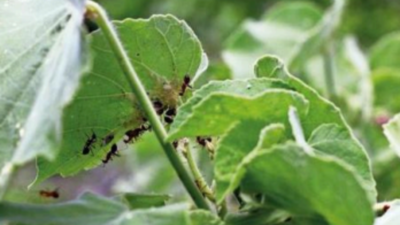- News
- City News
- bengaluru News
- Unseasonal rain can cause yellow crazy ant attacks in Karnataka too: Experts
Trending
This story is from September 2, 2022
Unseasonal rain can cause yellow crazy ant attacks in Karnataka too: Experts
Scientists say that warmer climates and increasing temperatures are probably boosting metabolic rates among yellow crazy ants and causing them to eat more.

In the third week of August, the invasive species of yellow crazy ants reportedly exploded all over Karanthamalai forest of Dindigul district, Tamil Nadu.
BENGALURU: Scientists say that warmer climates and increasing temperatures are probably boosting metabolic rates among yellow crazy ants and causing them to eat more.
Entomologists from Ashoka Trust For Research In Ecology And The Environment (ATREE), Bengaluru, say they cannot see any other reason for the population explosion among yellow crazy ants.
In the third week of August, the invasive species of yellow crazy ants reportedly exploded all over Karanthamalai forest of Dindigul district, Tamil Nadu. Villagers from the area left their ant-infested homes and chased their cattle away from these tiny insects, which attack by spraying formic acid in the eyes.
"Climate change is the primary reason for this population explosion as per our observations," Priyadarshan Dharmarajan, senior fellow at ATREE, told TOI.
"Simultaneous hot, humid and wet conditions and increased productivity of the landscape due to summer showers might have favoured the ants' metabolic activities thus enabling faster reproduction, population growth and spreading," their report stated.
Asked if Karnataka's towns and villages could come under a similar attack, the team said such invasions are very much possible even in Bengaluru. Unseasonal showers have become common in the city over the past few years and similar yellow crazy ant activities have been seen on its fringes such as forests of Nagarahole, BR Hills and Nandi Hills.
"They are not indigenous to India and their place of origin is unconfirmed. They are not life-threatening but they are fearless hunters, who wipe out the local flora and fauna. They forage everywhere and everything. Human beings can experience allergic reactions if touched or sprayed on by a yellow crazy ant. Some in the affected villages of Tamil Nadu have swollen limbs since the invasion," Dharmarajan added.
As of now, their presence in Karanthamalai forest is overwhelmingly huge and people are reporting getting covered by them on stepping out of homes.
Entomologists from Ashoka Trust For Research In Ecology And The Environment (ATREE), Bengaluru, say they cannot see any other reason for the population explosion among yellow crazy ants.
In the third week of August, the invasive species of yellow crazy ants reportedly exploded all over Karanthamalai forest of Dindigul district, Tamil Nadu. Villagers from the area left their ant-infested homes and chased their cattle away from these tiny insects, which attack by spraying formic acid in the eyes.
"Climate change is the primary reason for this population explosion as per our observations," Priyadarshan Dharmarajan, senior fellow at ATREE, told TOI.
A team of entomologists from Bengaluru visited the village and observed that while yellow crazy ants are common in the region and have been present across the Indian subcontinent for 100-200 years, the troublesome explosion in their population was linked to unseasonal and incessant summer showers triggered by climate change.
"Simultaneous hot, humid and wet conditions and increased productivity of the landscape due to summer showers might have favoured the ants' metabolic activities thus enabling faster reproduction, population growth and spreading," their report stated.
Asked if Karnataka's towns and villages could come under a similar attack, the team said such invasions are very much possible even in Bengaluru. Unseasonal showers have become common in the city over the past few years and similar yellow crazy ant activities have been seen on its fringes such as forests of Nagarahole, BR Hills and Nandi Hills.
"They are not indigenous to India and their place of origin is unconfirmed. They are not life-threatening but they are fearless hunters, who wipe out the local flora and fauna. They forage everywhere and everything. Human beings can experience allergic reactions if touched or sprayed on by a yellow crazy ant. Some in the affected villages of Tamil Nadu have swollen limbs since the invasion," Dharmarajan added.
As of now, their presence in Karanthamalai forest is overwhelmingly huge and people are reporting getting covered by them on stepping out of homes.
End of Article
FOLLOW US ON SOCIAL MEDIA










